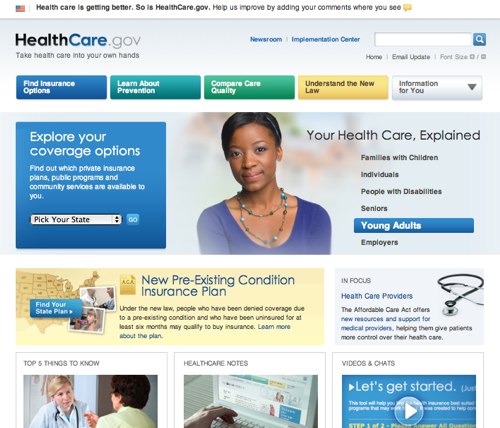Start here. According to one specialist, healthcare.gov contains 500 million — yes, 500 million — lines of software code. By contrast, a large bank’s computer system will typically contain 100 million lines of code. Additionally, the project management here seems like a bit of a disaster. CGI Federal did most of the work on the system, but didn’t do integration work. Q.S.S.I., which seems to have some ties to UnitedHealth Group, did the identity work. Managing multiple contractors on a situation of this size (and visibility) is obviously fairly challenging. Of course, the issue could also be the amount of money the project had at the front, or it could be Health and Human Services taking a while to define goals and parameters — hence CGI (which is based in Montreal, oddly, and is only the 29th-largest federal IT contractor) couldn’t really get started on time anyway.
It also bears noting here that CGI’s stock is up four percent since the launch of ObamaCare’s portal.
We have a “tech surge” coming involving “the best and the brightest,” which is moderately awkward because of David Halberstam’s book, which basically describes how whiz kids in the Kennedy administration completely bungled our involvement in Vietnam. Additionally, a “tech surge” might not be the best idea — there’s a thing in software development called “Brooks’ Law,” whereby adding late manpower to a software project tends to make it later. As it stands right now, the “cut-off” date seems to be around December 15 for January 1 enrollment (although under the current marketplace guidelines, you only need to be enrolled for nine months of a given 12-month period, so these dates are somewhat soft). December 15, though, is only about seven weeks away. Adding new cooks to this $400 million kitchen might not be the ideal plan. Actually, maybe the ideal plan would be to show some empathy for the people behind HealthCare.gov. After all, while this Hangout has a high buzzword quality to it, this discussion also paints a rosy picture of how the whole thing should be working:
Considering that some of the smartest people in America (and Canada!), i.e. the truly “best and brightest,” might not want to work for the government or federal IT contractors, maybe the solution here is simply to go open-source on the whole thing. Bloomberg has similar ideas. And maybe this could be a snapshot of what we need for the entire system — which is to say, less government and more transparency. This video explains the confusion and bureaucracy that has plagued American health care — and, while European health care is hardly ideal, has been a bit better across da pond:
I hardly have a clue what the solution here is. I run a series of junky WordPress and Tumblr sites, so clearly I have no technical oversight ability, nor have I ever federally contracted (although it sounds vaguely cool in some respects). It just seems like the big issues are the same all the time: here’s a grand plan, but the execution of the plan requires people who have a hard time communicating, and the plan blows up, and everything on the back end is about apologizing, looking for the right blame sources, and moving on with more people (because the solution to everything in a work capacity always seems to be “get more people,” never “identify the core problem and fix it with the people uniquely suited to do so”). Anyway, I clearly digress. Health care, as a broad concept, is kind of a wreck in the U.S. This idea is rooted in good, but needs help. This rollout will be, unfortunately, a good deal of what people remember about the idea, even weeks hence. That’s a rocky jump off. In the meantime: You ain’t got no problem, Jules. I’m on the motherfucker. Go back in there, chill them out, and wait for the calvary, which should be coming … directly.
